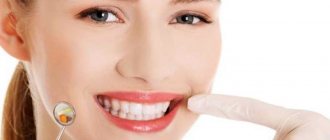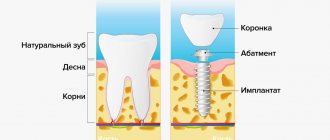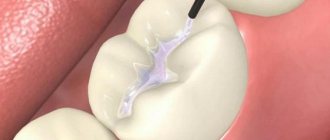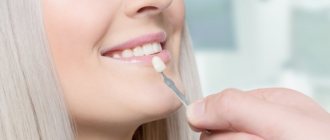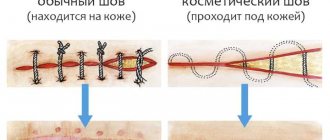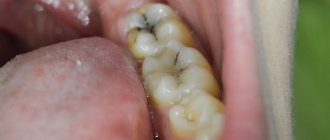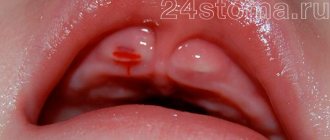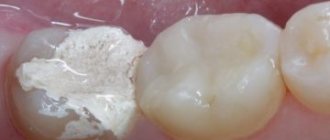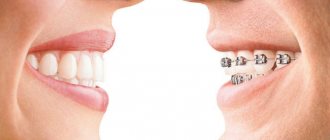A light filling, also known as photopolymer, requires limiting the intake of solid and coloring foods within 24 hours from the moment of installation. The patient should also refrain from smoking and drinking hot drinks. Failure to follow these recommendations can lead to a number of negative consequences, from deformation of the filling material to reduced service life of the structure.
Features of light seals
The composition of the light filling, as well as the technique of its installation, differs from other composite materials. The photopolymer contains a mixture of resins, fillers and silanes. This material hardens only under the influence of ultraviolet radiation, which affects the filling technique. To restore the integrity of the crown, the dentist applies the composition in layers, using a special blue lamp after each layer.
Photopolymer fillings have advantages over other types of composites:
- plasticity of the composition and controlled hardening - the specialist has the opportunity to apply the material without haste, which will avoid the formation of gaps or the creation of an unaesthetic surface of the dental crown;
- minimal content of toxic substances in the composition - due to the low level of toxins, there are practically no contraindications for the use of the material regarding the health status and age of the patient;
- simplified final processing - the composite can be easily polished, which makes it possible to create a smooth surface that prevents damage to the enamel of the opposite tooth, tongue and soft tissues;
- the ability to select an individual shade - the material can be almost identical in color to other teeth;
- natural shape - the plasticity of the composite allows the specialist to create the shape of a natural crown;
- service life - if the recommendations are followed, the seal will last at least 5 years.
The light filling has one significant drawback - the composite is not used when lesions are too large, or in hard-to-reach places.
Additional Information
Cigarettes are the culprit of many diseases, including dental ones.
Toxic compounds negatively affect the condition of the dentition. Smoking leads to cracks, yellowing of the enamel, the formation of caries, and also reduces the local immunity of the oral cavity and can cause stomatitis in a smoker or cause discomfort on the tongue.
When can I smoke after having a temporary filling installed?
Temporary filling protects exposed nerves and saves the tooth from subsequent destruction. You can smoke immediately with a temporary filling .
After all, after a week, the temporary material will be replaced with permanent one.
The main thing is to rinse your mouth thoroughly after each cigarette you smoke . You can use special tools.
When can I smoke after having a permanent filling installed?
Remember! To maintain oral health, it is necessary to completely abandon this harmful habit.
If a smoker has permanent fillings installed, then you can return to cigarettes 5-6 hours after the procedure.
When to eat mono after filling?
People who have ever had a filling installed know that you can eat no earlier than two hours later. This time is enough for the material to acquire the required hardness and be well fixed in the tooth crown.
Modern materials differ from classical composites, so the question of whether it is possible to eat after a light filling is relevant. Dentists have different opinions regarding how long after a light filling can be eaten without the risk of damage. Some experts are of the opinion that after a light filling you can eat immediately. This is explained by the properties of photopolymers. The material hardens under the influence of ultraviolet rays, which means that after the procedure is completed, the filling should not be exposed to external influences.
However, the risk is not completely excluded. For complete confidence in the readiness of the material, and most importantly, its reliable fixation in the tooth. For this reason, most experts, when asked “how long not to eat after installing a light filling,” recommend refraining from eating and drinking for at least 2 hours.
How soon can you drink alcohol after anesthesia?
How soon can you drink alcohol after anesthesia? The period is determined by the dentist and depends on the nature of the intervention and the type of treatment. Anesthesia is not immediately processed, so the feast should be postponed. After dental procedures, you must wait at least a day. It is permissible to drink alcohol 48 hours after the medication has been completely removed from the body.
Alcoholic drinks can greatly affect the outcome of treatment. As a result, dental intervention will be ineffective and unsuccessful. No matter how much you want to overcome anxiety and stress, it is better to forget about alcohol-containing drinks during the procedure.
What products should you be careful with?
How soon can you eat after installing a reflective filling? There is no definite answer. But regarding the food consumed, experts agree. Thus, it is recommended to exclude coloring products for 2–3 days after a light filling. Ingestion of foods, including drinks, containing dyes may affect the color of the composite, since the filling is still highly permeable.
After restoring teeth with a light filling, it is better to avoid the following foods for at least two days:
- coffee;
- beet;
- carrot;
- blueberry;
- carbonated drinks;
- chocolate and cocoa.
In small quantities you can use:
- black tea;
- strawberry;
- cherries;
- natural juices.
Dentists pay special attention not only to when and what not to eat with a light filling, but also to the temperature of the food eaten. You should not eat too hot or cold foods, or eat them one after another or together. The temperature contrast can lead not only to damage to the filling, but also to damage to the tissues of a healthy and diseased tooth.
Food restrictions
During the first few days after the filling procedure, fresh fillings are extremely sensitive, and they are especially susceptible to the effects of certain products. To protect the delicate area from unwanted staining, you should avoid consuming certain foods for 2-3 days. Such as:
- red wine;
- strong tea and coffee;
- various sauces;
- dark colored grapes;
- berries, especially brightly colored ones;
- some vegetables (carrots and beets).
You should also exclude some solid foods from your diet. These products can cause the new filling to chip and destroy it. This:
- various nuts;
- unpeeled seeds;
- hard fruits;
- crackers, croutons and bagels.
This kind of diet will help preserve the new filling and give it time to gain a foothold in the oral cavity. Therefore, you should not neglect this advice to get a good result after filling.
What complications can there be?
After the light reflection filling is installed, how long before you can eat? Our clinic specialists advise patients to abstain from food for 2 hours and from drinking for 1 hour. Such recommendations are not mandatory, but they can reduce the risk of complications after filling.
If the recommended time interval is not observed, complications may arise:
- rapid darkening of tooth enamel;
- staining of enamel (under the influence of dyes);
- It's a dull pain;
- swelling of the gums;
- crown destruction;
- filling falling out.
Also, in the first days after filling, patients should avoid eating any foods with increased hardness. In particular, it is not advisable to chew seeds, nuts or objects (for example, a pencil or pen).
How alcohol and anesthesia are combined
On the day of visiting the dentist, drinking alcohol is strictly prohibited because:
- it is unknown how the body will react to a mixture of alcohol and anesthesia, because these two chemicals after interaction can produce an unpredictable reaction;
- ethyl alcohol, contrary to the opinion about its anesthesia abilities, can neutralize the effect of the drugs themselves;
- double load on the liver;
- and in general, a doctor can refuse to admit a patient under his supervision; he has every right to do so.
Drinking alcohol after filling the teeth completely depends on the complexity and duration of the work being carried out; in this case, at least a day should pass after filling or grinding the teeth.
If the seal falls out or is damaged
If there is any deformation of the light filling, no action should be taken without first consulting a doctor. If it is not possible to visit the clinic, you can get a consultation by phone. But at the first opportunity, go to the dentist.
If there is a filling, it is important to prevent food particles from entering the tooth cavity. This can lead to inflammation and even the rapid development of a purulent process.
To summarize, we can conclude: eating after filling with photopolymers is acceptable, but with extreme caution. If the patient does not have a strong need for food, it is recommended to eat after 2 hours. Thus, the risks of complications are minimized.
Why should you avoid alcohol after dental anesthesia?
Drinking alcohol after a tooth has been frozen and its subsequent removal is not recommended.
Compositions such as Lidocaine, Novocaine, Ultracaine, and some others are used as freezing during treatment. These medicinal compositions act in such a way that the analgesic effect is exerted on a specific area, locally.
But, when the action of the active components of the drugs ends, the anesthetic substance penetrates the blood, entering the liver tissue. If you drink alcohol after dental anesthesia, the liver will receive an increased load. The filter organ will not be able to produce a sufficient amount of the enzyme responsible for the simultaneous breakdown of alcohol and medicine. As a result, poisoning may occur, because an increased amount of toxic substances will accumulate in the blood.
Liver cells in the process of increased production of the enzyme responsible for the breakdown of ethanol can be destroyed. This is how the body can react to alcohol after dental anesthesia. Medications from another category prescribed during treatment can also increase the effect of painkillers when combined with alcohol. This applies to antibiotics and drugs with an analgesic effect.
If you drink alcohol after dental anesthesia, the following consequences for the body are possible:
- increased blood pressure;
- increased heart rate;
- dizzy;
- nausea;
- weakness;
- breathing problems.
Alcohol after dental anesthesia can have an effect on brain activity.
From all that has been said, it is necessary to form a competent conclusion. If you drink alcohol after dental anesthesia, the active substances of the pain relief drug will remain in the blood for an indefinite time. As a result, the risk of toxic poisoning increases. Therefore, a person planning a medical appointment should not have any thoughts about whether it is possible to drink alcohol after dental anesthesia.
Yellow teeth from chifir and cigarettes
Why do teeth turn yellow from chifir and cigarettes? Using chifir along with nicotine can aggravate the problem of yellow teeth. The consequences of consuming chifir are a strong coloring effect.
Tea contains a substance called tannic acid, which gives it its dark color. When teeth have grooves, tannic acid will settle into them, causing discoloration over time.
With a large amount of tea leaves in chifir, the teeth turn yellow, black, and possibly tooth loss.
Special toothpaste is not the solution. Due to its high abrasive ability, this paste cannot be used constantly; it wears away the enamel.
What causes the color to change
Discoloration of enamel occurs as a result of thinning of its top layer, which leads to exposure of pores. This situation contributes to the unhindered penetration of chromogens into them - organic pigments contained in products.
Often the cause of enlarged pores is the use of products containing acids, which help loosen the enamel.
Thinning enamel occurs in people of all ages. In adults, changes in dental tissue can be age-related; in young people, they can be caused by frequent consumption of acid-containing drinks or foods.


